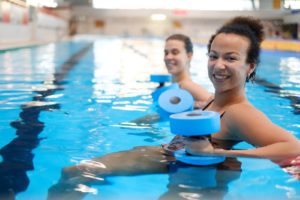Benefits of Aquatic Therapy

Multiracial couple attending water aerobics class in a swimming pool.
For decades, aquatic therapy has been a safe alternative to traditional land-based therapy. Aquatic therapy is a form of physical therapy in a pool or other aquatic-like environment under the supervision and guidance of a trained physiotherapist.
Other popular names for aquatic therapy include aquatic rehab, aqua therapy, therapeutic aquatic exercise, pool therapy, or hydrotherapy.
Aquatic therapy uses the physical properties of water to assist patients in healing from various medical conditions. This low-impact way of exercising and recovery is excellent for people of all ages, even those recovering from surgery or debilitating conditions.
3 Benefits of Aquatic Therapy
Aquatic therapy is an excellent option for people who are injured, disabled, or who can’t perform exercises on land safely. Compared to other styles of physical therapy, hydrotherapy is a less intense and more joint-friendly way of exercising and building strength.
1. Less Muscle and Joint Stress
Perhaps one of the most significant benefits of aquatic therapy is that while people are submerged in water, the water supports the patient’s weight. The buoyancy of water reduces the impact on weight-bearing bones by 50%. Because of this, aquatic therapy is a common therapy in the treatment of arthritis, surgery rehabilitation, and injury rehabilitation.
Since the water offers natural resistance, it also promotes muscle strengthening without the need for weights that can be too much for some people to handle. In addition, the resistance can help strengthen major muscle groups without placing additional stress and pressure on their joints, which could lead to further injury.
All of this also helps speed functional mobility while eliminating the risk of failing, which is a factor in traditional physical therapy.
2. Decreased Swelling
Hydrotherapy can help decrease swelling by using hydrostatic pressure. This pressure provides positional awareness to help the joints maintain a stable position. This is key for patients rehabilitating from joint sprains, torn ligaments, and patients dealing with joint problems. This gentle pressure to reduce soft tissue swelling can also help those with arthritic disorders manage joint and ligament pain better.
The water’s resistance can help encourage balance and coordination while maintaining and regaining muscle tone.
3. Improved Circulation
Lastly, another of the widespread benefits of aquatic therapy is related to circulation. Most of these exercises are performed in warm water pools to help relax the muscles even further and increase blood flow to injured areas. Patients healing from back pain, fibromyalgia, and muscle spasms find aquatic therapy particularly helpful and therapeutic for their ailments.
The pressure of water can also assist in lowering blood pressure, assist with exhalation, and help with breathing while exercising.
Conditions That May Benefit from Aquatic Therapy
Aquatic therapy is popular physiotherapy used in the treatment, management, and recovery of various health conditions. Some of these include:
- Arthritis
- Balance disorders
- Bursitis
- Cerebral palsy
- Chronic pain
- Depression
- Joint surgery
- Fibromyalgia
- Post-surgical conditions
- Lower back pain
- Osteoarthritis
- Parkinson’s disease
- Multiple sclerosis
- Rheumatoid arthritis
- Scoliosis
- Chronic stress
- Spinal cord injury
- Sprains and strains
- Strokes
- Tendonitis
- Traumatic brain injury
Types of Aquatic Therapy Equipment
Besides a pool, there are other types of water therapy equipment you can find at psychical therapy units, including:
- Underwater treadmills: these treadmills are submerged in water and are used to help people recover from injuries as they regain muscle and body motion after surgery.
- Stationary bikes: similar to the treadmills, these are stationary bikes attached to the bottom of a pool to offer some resistance to people recovering from injury.
- Pool noodles: the classic pool noodles kids use can also be part of hydrotherapy to provide patients stable and comfortable support while performing exercises. They can also be used as upper-body “weights” while people perform activities in the pool.
Different types of therapies will call for different kinds of tools and equipment. Ankle weights, barbells, flippers, and resistance bands are all commonly used in hydrotherapy exercises.
—
Geraldine Orentas is a writer from Happy Writers, Co. in partnership with AdvanceOnline, an online health and safety training provider.
